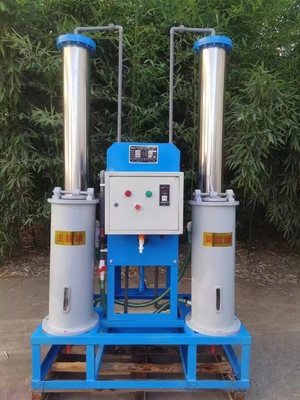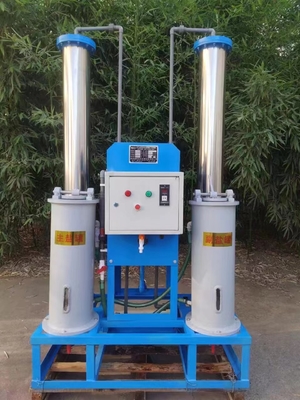-
Condensate Water Recovery Device
-
Reverse Osmosis Equipment
-
Fully Automatic Water Softener
-
Industrial Sand Filter
-
Water Supply Equipment
-
Chemical Dosing Device
-
Container Flipper
-
Container Loading and Unloading Machine
-
Truck Flipper
-
Electric Transfer Cart
-
Electronic Weighbridge
-
Mobile Loading Dock Ramp
-
Air Compressor Heat Recovery
-
Water Treatment Accessories
Capacity Fully Automatic Water Softener Tonglida FRP Dual Tank Equipment 1-100T/H

Contact me for free samples and coupons.
Whatsapp:0086 18588475571
Wechat: 0086 18588475571
Skype: sales10@aixton.com
If you have any concern, we provide 24-hour online help.
x| Features | High Automation Level, Stable Water Quality, High Efficiency, Low Energy Consumption, Low Operating Costs. | Origin | Taian, Shandong |
|---|---|---|---|
| Brand | Tonglida | Product Information | Automatic Water Softening Equipment - Dual-Tank, Single-Tank, Continuous Water Production |
| Product Specifications | 1-100T/H | Materials | Fiberglass Reinforced Plastic (FRP), Stainless Steel, Carbon Steel |
| Application Fields | Industrial Boilers, Central Air Conditioning Systems, Heat Exchangers, Hotels, Restaurants, Food And Chemical Industries, Laundry And Dyeing, Medical And Sanitation, Etc. | ||
| Highlight | automatic softening water treatment equipment,frp fully automatic water softener,frp softening water treatment equipment |
||
Product Description:
The fully automatic water softener comes equipped with a comprehensive automatic control system that can be customized as a single-tank or dual-tank system according to user requirements. The entire system operates automatically, with one tank in use while the other serves as a backup.
When the operating tank reaches the set water production capacity, it automatically goes into regeneration mode, and the backup tank takes over the operation. The entire softening system operates in a fully automatic mode, and the operation of the softening tank includes several process stages: running, backwashing, brine suction, ion exchange, forward flushing, and standby.
The raw water flows through the resin tank containing ion exchange resin, which is equipped with an automatic control valve. The exchangeable ions Na+ in the resin undergo ion exchange with the cations (Ca2+, Mg2+) in the water, resulting in the water hardness of the softener outlet being ≤0.03mmol/L.
When the system reaches the set flow rate, the controller automatically initiates the regeneration process. The main steps involved are as follows:
- Backwashing: Water is directed upward through the bottom distributor to flush and loosen the resin bed, simultaneously removing accumulated suspended particles from the resin surface.
- Brine Suction Regeneration: Saturated brine solution is injected into the resin tank through the brine injector after dilution to a concentration of 5-8%. The brine solution flows downward through the deactivated resin bed, regenerating the resin and restoring its original exchange capacity.
- Exchange: The exchange process consists of two steps. In the first step, after the regeneration liquid is injected, there is still some regeneration brine in the upper space of the resin tank that has not participated in the regeneration process. To fully utilize this brine, clean water with the same flow rate as the regeneration liquid is used to thoroughly regenerate the uninvolved brine through the resin bed. This step is called exchange. In the second step, the regeneration waste liquid in the resin pores is displaced from the resin bed.
- Forward Flushing: The purpose of forward flushing is to completely remove the residual regeneration waste liquid from the resin bed and clean it until the water meets the required standards.
| Project Name | Unit | 1T/H | 10T/H | 25T/H | 35T/H | 40T/H | 50T/H | 60T/H | 80T/H | 100T/H | |
| Inlet pressure | mpa | 0.15-0.25 | |||||||||
| Water production | T/H | 0.8-1.2 | 9-11 | 23-27 | 32-38 | 35-45 | 45-55 | 55-65 | 70-90 | 90-110 | |
| Raw water turbidity | O | ≤2 | |||||||||
| Raw water hardness | mmol/L | ≤15 | |||||||||
| Residual hardness of soft water | mmol/L | ≤0.03 | |||||||||
| Self-consumption water rate | % | 4 | |||||||||
| Power supply | Single-phase electricity 50HZ 220V | ||||||||||
| Diameter of exchange column | Stainless steel head | mm | ∅650 | ∅750 | ∅900 | ∅900 | ∅1000 | ∅1200 | ∅1400 | ||
| Ordinary head | mm | ∅160 | ∅420 | ∅640 | ∅760 | ∅890 | ∅900 | ∅1000 | ∅1180 | ∅1400 | |
| Resin tank height | mm | 1800 | |||||||||
| Inlet and outlet water pipeline | Solenoid valve | mm | DN15 | DN65 | DN65 | DN80 | DN80 | DN100 | DN125 | DN150 | |
| Valve body | mm | DN20 | |||||||||
| Flow meter | L/H | 60 | 160 | 400 | 600 | 1000 | 1000 | 2000 | 2000 | 2500 | |
| Resin filling capacity | Solenoid valve | KG | |||||||||
| Total weight of equipment | KG | ||||||||||
| Salt tank size | Self-processing | mm | 225*650 | 410*650 | 640*750 | 640*750 | 700*850 | 760*800 | 760*800 | 890*800 | |
| Purchase from outside | 800L | 1000L | 1500 | 2000 | |||||||
Features:
Our product boasts a high level of automation, ensuring a streamlined process. The stable water quality produced by our system guarantees consistent output quality, which leads to fewer rejections and less waste. Our technology is also highly efficient, maximizing the output while minimizing the resources needed.
In addition, our system consumes low amounts of energy, making it both cost-effective and environmentally friendly. With less energy being used, there is a significant reduction in operating costs, which translates into savings for our customers.
Technical Parameters:
Automatic control with simple and reliable operation.
The equipment is designed with automatic control that ensures simple and reliable operation. This feature reduces the need for manual intervention, which, in turn, reduces the risk of human error.
Strong adaptability, capable of softening water with high hardness up to ≤15mmol/L to residual hardness ≤0.03mmol/L in a single pass.
The equipment is highly adaptable and can soften water with high hardness up to ≤15mmol/L to residual hardness ≤0.03mmol/L in a single pass. This means that it can effectively remove impurities from the water, resulting in cleaner and clearer water for use.
Short regeneration time, low resin consumption, low salt consumption, stable water quality, and low operating costs.
The equipment also has a short regeneration time, low resin consumption, and low salt consumption, which make it highly efficient. Additionally, it is designed to ensure stable water quality, thereby reducing operating costs.
Lightweight equipment with a compact and rational design, requiring a small footprint.
The equipment is lightweight and has a compact and rational design, which means that it requires a small footprint. This is particularly important for small spaces where there is limited room for installation.
The complete machine is delivered from the factory, and installation is simple. Only the inlet and outlet pipes and power supply need to be connected to start water production.
Installation is simple and straightforward, with the complete machine delivered from the factory. Only the inlet and outlet pipes and power supply need to be connected to start water production. This makes the equipment easy to use and maintain.
Applications:
The circulating makeup water in various systems such as steam boilers, hot water boilers, heat exchangers, steam condensers, air conditioning systems, and direct-fired equipment and systems requires treatment to enhance their performance. One of the effective and widely used treatments is the automatic water softener.
In addition to these systems, automatic water softeners are also preferred for domestic water treatment. They are extensively used in various industrial sectors such as food, electroplating, pharmaceuticals, chemicals, printing and dyeing, textiles, and electronics. This is because it helps in the efficient treatment of hard water content commonly present in these sectors.
The automatic water softener's basic function is to reduce the water hardness produced in these systems through single-stage or multi-stage softening processes. It effectively eliminates the hard water's minerals and other impurities that can create problems such as scale buildup, corrosion, and damage to heat transfer surfaces. Furthermore, it is also used as pre-treatment for scale reduction in desalination systems.




